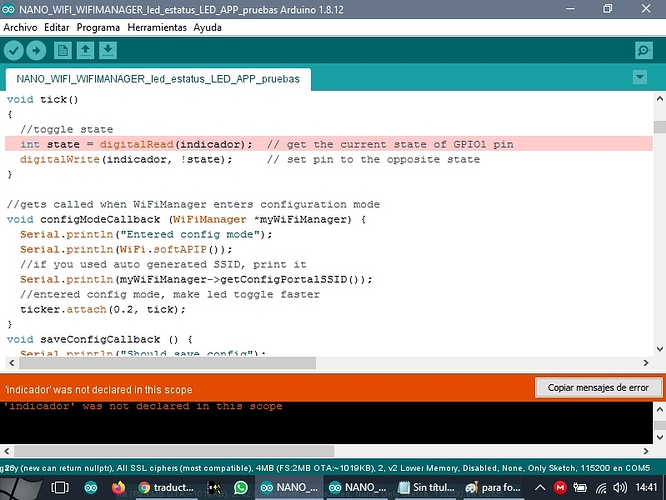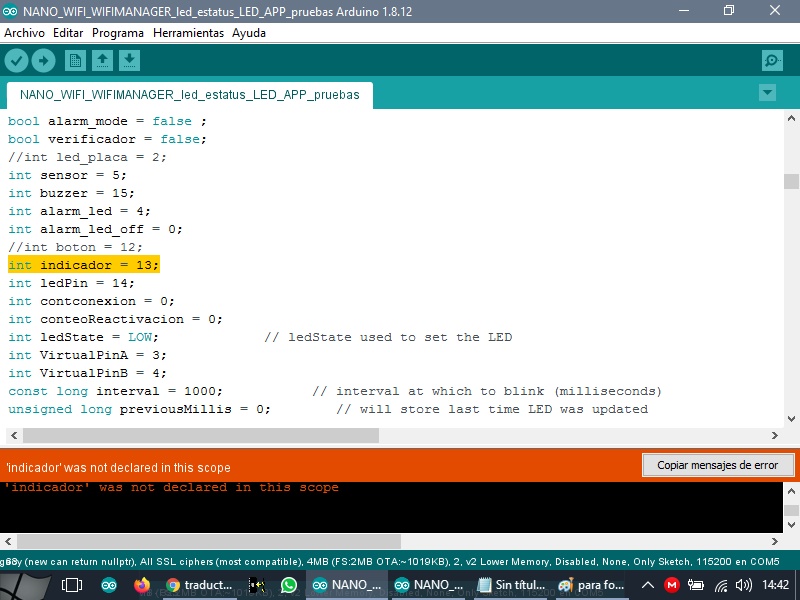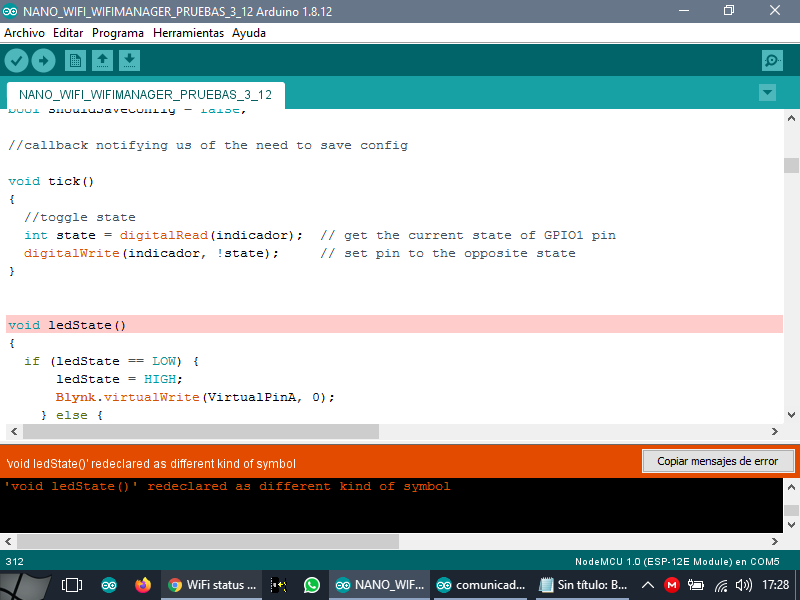hello people, me again, I’m trying that the wifi status indicator of the wifimanager library is not the one that comes by default “BUILTIN_LED” I want to use another one that I already have in the code, and I can’t compile … "Was not declared in this scope "as I show in the images is well declared, can you help me?
#include <FS.h>
//#define BLYNK_PRINT Serial
#include <ESP8266WiFi.h>
#include <BlynkSimpleEsp8266.h>
#include <DNSServer.h>
#include <ESP8266WebServer.h>
#include <WiFiManager.h>
#include <ArduinoJson.h>
//for LED status
#include <Ticker.h>
Ticker ticker;
//define your default values here, if there are different values in config.json, they are overwritten.
char mqtt_server[40];
char mqtt_port[6] = "8080";
char blynk_token[34] = "zUDZm-EtQq9arxeaE1IJZtAjFi_uCI3L";
//flag for saving data
bool shouldSaveConfig = false;
//callback notifying us of the need to save config
void tick()
{
//toggle state
int state = digitalRead(indicador); // get the current state of GPIO1 pin
digitalWrite(indicador, !state); // set pin to the opposite state
}
//gets called when WiFiManager enters configuration mode
void configModeCallback (WiFiManager *myWiFiManager) {
Serial.println("Entered config mode");
Serial.println(WiFi.softAPIP());
//if you used auto generated SSID, print it
Serial.println(myWiFiManager->getConfigPortalSSID());
//entered config mode, make led toggle faster
ticker.attach(0.2, tick);
}
void saveConfigCallback () {
Serial.println("Should save config");
shouldSaveConfig = true;
}
// Keep this flag not to re-sync on every reconnection
bool isFirstConnect = true;
// This function will run every time Blynk connection is established
BLYNK_CONNECTED()
{
if (isFirstConnect)
{
// Request Blynk server to re-send latest values for all pins
Blynk.syncAll();
isFirstConnect = false;
}
}
bool alarm_mode = false ;
bool verificador = false;
//int led_placa = 2;
int sensor = 5;
int buzzer = 15;
int alarm_led = 4;
int alarm_led_off = 0;
//int boton = 12;
int indicador = 13;
int ledPin = 14;
int contconexion = 0;
int conteoReactivacion = 0;
int ledState = LOW; // ledState used to set the LED
int VirtualPinA = 3;
int VirtualPinB = 4;
const long interval = 1000; // interval at which to blink (milliseconds)
unsigned long previousMillis = 0; // will store last time LED was updated
BlynkTimer timer;
void myTimerEvent() {
Serial.println("Tiempo des en seg: " + String(conteoReactivacion));
if (alarm_mode == false) {
conteoReactivacion++;
if (conteoReactivacion >= 1800) { //son 30 minutos es 1800 segundos dividido en 3 da 600 segundos por el delay que se le da a V0 de 3000 milisegundos para retrasar el pulso de disparo por 3 segundos
Blynk.virtualWrite(V1, 1);
digitalWrite(alarm_led, HIGH);
digitalWrite(alarm_led_off, LOW);
alarm_mode = true;
}
} else {
conteoReactivacion = 0;
}
if (digitalRead(sensor) == 0) {
Blynk.virtualWrite(V0, "NORMAL");
delay(3000);
}
if (digitalRead(sensor) == 1)
{
Blynk.virtualWrite(V0, "ALERTA");
if (alarm_mode == true)
//AUTOR ALEXIS MORA
{
Blynk.email("ale24cba@gmail.com", "Historial de Alarmas", "Alarma Disparo");
Blynk.notify("Alarma Disparo");
digitalWrite(buzzer, HIGH);
delay(500);
digitalWrite(buzzer, LOW);
}
}
}
BLYNK_WRITE(V1) {
Serial.println(param.asInt());
switch (param.asInt()) {
case 1: {
alarm_mode = true;
digitalWrite(alarm_led, HIGH);
digitalWrite(alarm_led_off, LOW);
break;
}
case 2: {
alarm_mode = false;
digitalWrite(buzzer, LOW);
digitalWrite(alarm_led, LOW);
digitalWrite(alarm_led_off, HIGH);
break;
}
}
}
void setup()
{
pinMode(sensor, INPUT_PULLUP);
pinMode(buzzer, OUTPUT);
pinMode(alarm_led, OUTPUT);
pinMode(alarm_led_off, OUTPUT);
//pinMode(boton, INPUT);
pinMode(indicador, OUTPUT);
// pinMode(led_placa, OUTPUT);
pinMode(BUILTIN_LED, OUTPUT);
// start ticker with 0.5 because we start in AP mode and try to connect
ticker.attach(0.6, tick);
// Debug console
Serial.begin(115200);
Serial.println();
//clean FS, for testing
//SPIFFS.format();
// Blynk.begin(auth, ssid, pass);
// Setup a function to be called every second
timer.setInterval(1000L, myTimerEvent);
// put your setup code here, to run once:
//clean FS, for testing
//SPIFFS.format();
//read configuration from FS json
Serial.println("mounting FS...");
if (SPIFFS.begin()) {
Serial.println("mounted file system");
if (SPIFFS.exists("/config.json")) {
//file exists, reading and loading
Serial.println("reading config file");
File configFile = SPIFFS.open("/config.json", "r");
if (configFile) {
Serial.println("opened config file");
size_t size = configFile.size();
// Allocate a buffer to store contents of the file.
std::unique_ptr<char[]> buf(new char[size]);
configFile.readBytes(buf.get(), size);
DynamicJsonBuffer jsonBuffer;
JsonObject& json = jsonBuffer.parseObject(buf.get());
json.printTo(Serial);
if (json.success()) {
Serial.println("\nparsed json");
//strcpy(mqtt_server, json["mqtt_server"]);
//strcpy(mqtt_port, json["mqtt_port"]);
strcpy(blynk_token, json["blynk_token"]);
} else {
Serial.println("failed to load json config");
}
configFile.close();
}
}
} else {
Serial.println("failed to mount FS");
}
//end read
// The extra parameters to be configured (can be either global or just in the setup)
// After connecting, parameter.getValue() will get you the configured value
// id/name placeholder/prompt default length
//WiFiManagerParameter custom_mqtt_server("server", "mqtt server", mqtt_server, 40);
//WiFiManagerParameter custom_mqtt_port("port", "mqtt port", mqtt_port, 6);
WiFiManagerParameter custom_blynk_token("blynk", "blynk token", blynk_token, 34);
//WiFiManager
//Local intialization. Once its business is done, there is no need to keep it around
WiFiManager wifiManager;
//set config save notify callback
wifiManager.setSaveConfigCallback(saveConfigCallback);
//set static ip
//wifiManager.setSTAStaticIPConfig(IPAddress(10,0,1,99), IPAddress(10,0,1,1), IPAddress(255,255,255,0));
//add all your parameters here
//wifiManager.addParameter(&custom_mqtt_server);
//wifiManager.addParameter(&custom_mqtt_port);
wifiManager.addParameter(&custom_blynk_token);
//reset settings - for testing
//wifiManager.resetSettings(); //borra usuario y contraseña cuando esta linea esta sin comentar al grabar.
//set callback that gets called when connecting to previous WiFi fails, and enters Access Point mode
wifiManager.setAPCallback(configModeCallback);
//set minimu quality of signal so it ignores AP's under that quality
// defaults to 8%
//wifiManager.setMinimumSignalQuality();
//sets timeout until configuration portal gets turned off
//useful to make it all retry or go to sleep
//in seconds
//wifiManager.setTimeout(120);
//fetches ssid and pass and tries to connect
//if it does not connect it starts an access point with the specified name
//here "AutoConnectAP"
//and goes into a blocking loop awaiting configuration
if (!wifiManager.autoConnect("NanoWifi", "12345678")) {
Serial.println("failed to connect and hit timeout");
delay(3000);
//reset and try again, or maybe put it to deep sleep
ESP.reset();
delay(5000);
}
//if you get here you have connected to the WiFi
Serial.println("connected...yeey :)");
//read updated parameters
//strcpy(mqtt_server, custom_mqtt_server.getValue());
//strcpy(mqtt_port, custom_mqtt_port.getValue());
strcpy(blynk_token, custom_blynk_token.getValue());
//save the custom parameters to FS
if (shouldSaveConfig) {
Serial.println("saving config");
DynamicJsonBuffer jsonBuffer;
JsonObject& json = jsonBuffer.createObject();
//json["mqtt_server"] = mqtt_server;
// json["mqtt_port"] = mqtt_port;
json["blynk_token"] = blynk_token;
File configFile = SPIFFS.open("/config.json", "w");
if (!configFile) {
Serial.println("failed to open config file for writing");
}
json.printTo(Serial);
json.printTo(configFile);
configFile.close();
//end save
}
while (WiFi.status() != WL_CONNECTED) {
int mytimeout = 5;
delay(500);
Serial.print(".");
if((millis() / 1000) > mytimeout ){ // try for less than 6 seconds to connect to WiFi router
Serial.println(" ");
break;
}
}
if(WiFi.status() == WL_CONNECTED){
//if you get here you have connected to the WiFi
Serial.println(" ");
Serial.println("connected to WiFi!! yay :)");
Serial.println("IP address: ");
Serial.println(WiFi.localIP());
ticker.detach();
//keep LED on
digitalWrite(indicador, LOW);
}
Blynk.config(blynk_token);
bool result = Blynk.connect();
if (result != true)
{
Serial.println("BLYNK Connection Fail");
Serial.println(blynk_token);
wifiManager.resetSettings();
ESP.reset();
delay (1000);
}
}
void loop()
{
Blynk.run();
timer.run(); // Initiates BlynkTimer
unsigned long currentMillis = millis();
if (currentMillis - previousMillis >= interval) {
previousMillis = currentMillis;
if (ledState == LOW) {
ledState = HIGH;
Blynk.virtualWrite(VirtualPinA, 0);
Blynk.virtualWrite(VirtualPinB, 1023);
} else {
ledState = LOW;
Blynk.virtualWrite(VirtualPinA, 1023);
Blynk.virtualWrite(VirtualPinB, 0);
}
}
}

